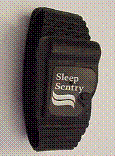Update |
|
October 29, 2009 The Sleep Sentry is gone again. While the company's website remains online, it isn't current. The company doesn't answer the phone or respond to phone or email messages. |
The Sleep Sentry is back. This device, which you can wear on either your wrist or ankle as you sleep, sounds an alarm when it detects one of the signs of hypoglycemia (low blood sugar). It will beep repeatedly if hypoglycemia causes your skin temperature to drop or your skin to perspire.

The Sleep Sentry
The Food and Drug Administration has approved new Sleep Sentry devices, which are now being shipped. Teledyne Avionics sold the original Sleep Sentries from 1984 to 1989, when Dr. Eric Orzeck, an endocrinologist practicing in Houston, purchased the rights and spare parts for the device. Until 1996 he was able to build units from those parts.
No one who bought those units ever returned them, Dr. Orzeck says. He continues to repair the original units.
“I have such devoted customers that sometimes they fly into Houston so that it can be repaired the same day and they do not have to be without it that night,” Dr. Orzeck says. “My last repair was 10 days ago. I’ll probably be doing it for years, I doubt that they’ll ever give them up even with the newer model.”
For the past five years Dr. Orzeck sought someone to begin making new units. Eventually, he formed a 50-50 partnership with Marvin Meier, a Canadian businessman who has been involved with diabetes for the past 25 years. Meier is the president and CEO of the company they set up, Diabetes Sentry Products Inc. in Bellingham, Washington. The toll-free phone number is (866) 270-5675 and the website is http://www.diabetessentry.com.
Dr. Orzeck and Meier didn’t change the design. “We just took it to the 21st century,” Dr. Orzeck says. That includes a thinner aluminum casing, an adjustable strap that won’t irritate the skin, and the use of lighter and better batteries.
The new Sleep Sentry is about 1/3 the weight of the original. It weighs 1.1 ounces, including the strap and three 357 watch batteries that are expected to last at least a year.
The Sleep Sentry, an attractive device that is professionally packaged, sells for $389 plus shipping and handling ($10 U.S., $15 Canada & Mexico, $25 international). It includes a one-year warranty but no longer has a 30-day money back guarantee.
Wake Up from Hypoglycemia
The Sleep Sentry will not work for everyone. Someone I know, who uses insulin to control her type 2 diabetes and occasionally experiences hypoglycemia at night, tried out the product. For three straight nights it beeped with false positive alarms. But when she used her meter to test her blood sugar, each time it was normal.
Extensive testing indicates that users may experience some false positives or false negatives. In 1983 three medical institutions tested the Sleep Sentry in studies submitted to the FDA for approval of the device. The conclusion reached then by the principal investigator, Dr. Julio Santiago, professor of pediatrics at the Washington University in St. Louis, remains the key consideration:
-
David Mendosa is a freelance journalist and consultant specializing in diabetes and lives in Boulder, Colorado. When he was diagnosed with type 2 diabetes in February 1994, he began to write entirely about that condition. His articles and columns have appeared in many of the major diabetes magazines and websites. His own website, David Mendosa’s Diabetes Directory, established in 1995, was one of the first and is now one of the largest with that focus. Every month he also publishes an online newsletter called “Diabetes Update.” Twice weekly he writes for his blog at http://blogs.healthcentral.com/diabetes/david-mendosa. He is a coauthor of What Makes My Blood Glucose Go Up...And Down? (New York: Marlowe & Co., August 2003, and second American edition coming July 10, 2006, and other publishers in the U.K., Australia, and Taiwan).
This article originally appeared in the September 2003 issue of Diabetes Wellness News, page 6. It is a revision of the article I originally submitted more than a year earlier. But just as the publication was going to press, the company advised me—and I advised Diabetes Wellness News—that the FDA approval that they thought they had was not valid. It is now.
Last modified: February 1, 2005
![[Go Back]](back-new.gif) Go back to Home Page
Go back to Home Page
![[Go Back]](back-new.gif) Go back to Diabetes Directory
Go back to Diabetes Directory



